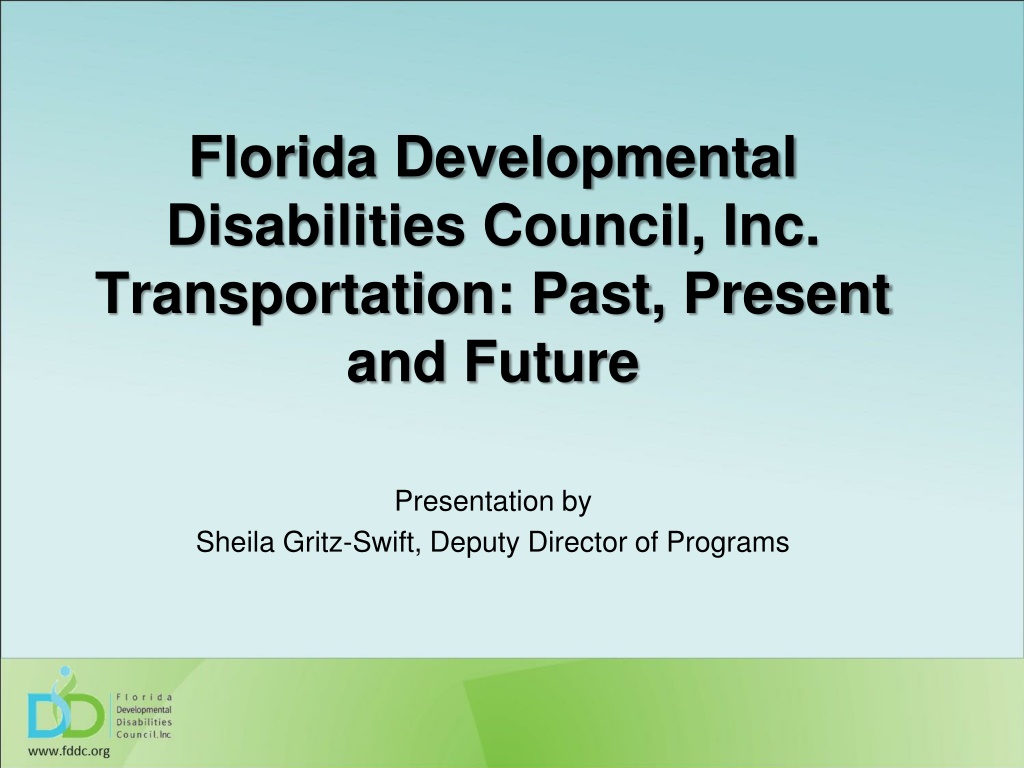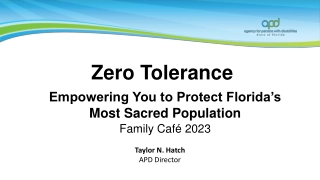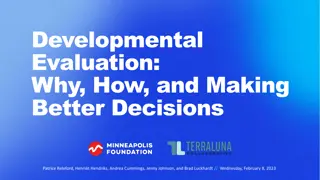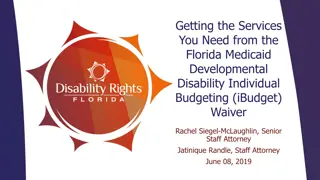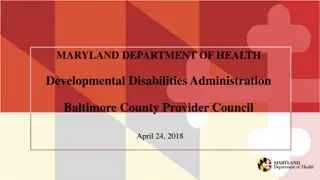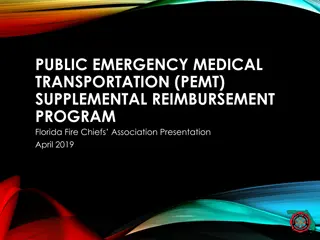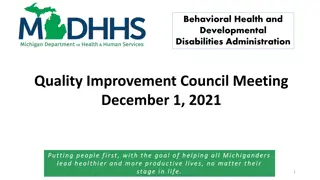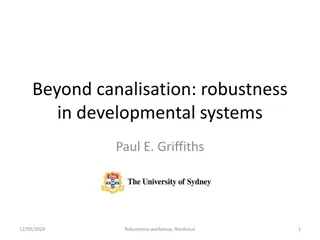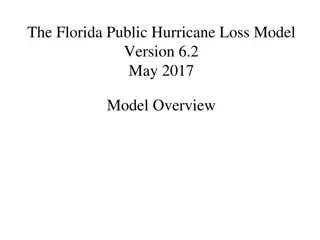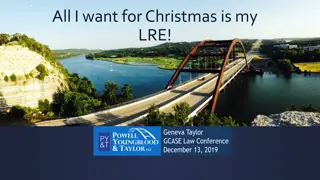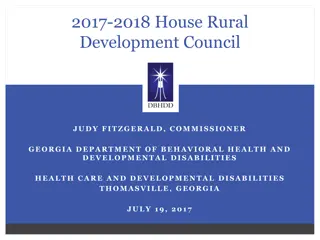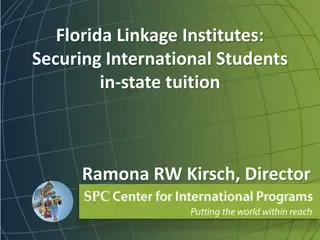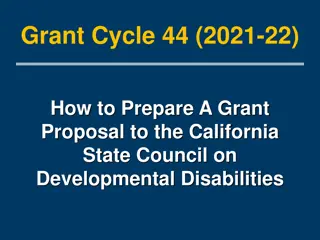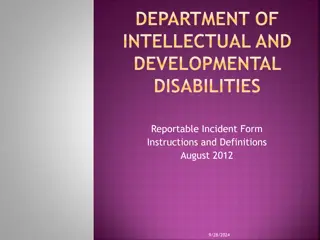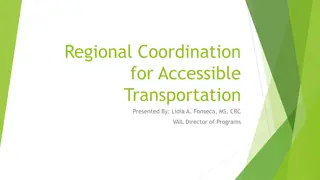Transportation Evolution: Florida Developmental Disabilities Council Initiatives
Sheila Gritz-Swift, Deputy Director of Programs, presents the journey of Florida Developmental Disabilities Council's transportation initiatives from the past to the future. The presentation showcases collaborations, major activities, awards, outcomes, and the impact of programs like the Transportation Voucher Pilot Project.
Uploaded on Sep 28, 2024 | 0 Views
Download Presentation

Please find below an Image/Link to download the presentation.
The content on the website is provided AS IS for your information and personal use only. It may not be sold, licensed, or shared on other websites without obtaining consent from the author. Download presentation by click this link. If you encounter any issues during the download, it is possible that the publisher has removed the file from their server.
E N D
Presentation Transcript
Florida Developmental Disabilities Council, Inc. Transportation: Past, Present and Future Presentation by Sheila Gritz-Swift, Deputy Director of Programs
2011-2016 Culmination of Transportation Stakeholders Group Collaboration with Florida Department of Transportation on Transportation Voucher Pilots Implementation of a Transportation Options Research Project 2
2017-2021 State Plan Goal, Objectives and Activities Culmination of 2011-16 initiatives in 2017 Transportation Goal Sustainable solutions Infrastructure change Increased access to safe and affordable transportation 3
2017-2021 Transportation Goal Major Activities Tentatively Planned Mobility Management Travel Training Data collection or database on unmet needs 4
Floridas Transportation Voucher Pilot Program: A Model for 24-Hour Inclusive Community Transportation 5
Conceptual Idea Transportation to employment, postsecondary education/training and the greater community Vouchers for requesting rides Sedans and paratransit with wheelchair lifts as needed Seven days a week, including nights, weekends and holidays at no additional cost to rider 6
Collaboration Florida Department of Transportation (FDOT) Florida Developmental Disabilities Council, Inc. (FDDC) Urban Model Hillsborough Area Regional Transition Authority (HART) HARTPlus Customer Choice Voucher Pilot Project Rural Model Citizens for Improved Transportation (CIT) 7
Awards and Implementation Start-up Funding Process/Procurement Pricing Quality Assurance Issues Along the Way 8
Outcomes and Impact HART mile trips to 7.6 mile trips 3 day notice to 24-hour transportation availability Improved access to community 27,813 trips at $16.00 a trip Cost of $445,008 versus $1,001,268 Total savings of $556,260 8% growth Self-supporting after one year of funding 9
Outcomes and Impact CIT Year 2 1,533 rides Approximately $54,912.06 to date (Year 2) for paratransit, monthly bus passes and taxis Employment, education and job training with majority for employment Working on sustainability and more options for flexible schedules 10
Outcomes and Impact CIT Belle Glade, South Bay and Pahokee residents $8.05 per hour to $16.00 per hour Access for training and employment Several riders unemployed and turning down jobs; now employed at $10.00 per hour Access to employment 11
Promising/Supporting Legislative Action 2017 CS/HB 221 Uber/Lyft Bill s. 627.748, F.S. Background checks Insurance requirements 12
Transportation Options Research Project 13
Desired Outcomes Identified evidence-based and promising practice programs and resources leading to new approaches that increase affordable and accessible transportation Improved knowledge of key transportation stakeholders Improved transportation services 14
Key Objectives of Project National research on affordable and accessible transportation options Gaps analysis between Florida and states with successful programs Recommendations for replication of successful practices 15
Key Components of Project Gap Analysis Florida Transportation Analysis (FTA) Florida Case Study (FCS) National Research Synthesis (NRS) Successful Practices/Recommendations Five primary/crucial needs from FTA Subordinate needs from FTA and FCS Recommendations from FCS and NRS 16
Florida Comprehensive Program Evaluation 140 120 100 80 60 40 20 0 Number Percent 17
Persons with Disabilities and Caregivers Endorsed Needs No evening transportation No transportation for recreation Timeliness (e.g., late pickups or long waits) Frequency of rides during the day Availability of stops Not willing to cross county lines Routes not near critical services Unable to make multiple stops Knowledge of the area by drivers 46 41 41 40 39 37 36 36 34 18
Persons with Disabilities and Caregivers Endorsed Needs Driver friendliness and knowledge of people with disabilities Driver turnover Poor communication of routes Cost of ride Ease of scheduling a pickup Wi-Fi availability Inability to have caregivers on paratransit Passes difficult to obtain online 30 29 25 23 22 18 18 13 19
Persons with Disabilities and Caregivers Endorsed Needs Language barrier with drivers Cleanliness Lack of understanding of AT needs Exact change needed Demeaning comments from passersby 11 8 7 4 3 20
Five Critical Need Categories 1. Reliable and Adequate Funding 2. Access and Expansion of Transportation Services 3. Transportation Cost, Quality and Collaboration 4. Client (Rider) Awareness and Understanding 5. Other Accessibility Issues 22
Five Critical Need Categories 300 250 200 150 100 50 0 Funding Access and Expansion Cost, Quality, Collaboration Awareness and Understanding Other Categories 23
1. Reliable and Adequate Funding Invest in paratransit vehicles and maintenance Improve uniformity in match/faster reimbursement Invest in hiring and retaining qualified drivers 24
2. Access and Expansion Issues Availability in rural areas Limited hours/schedules Availability of specialized vehicles Limited number or runs On-time transportation Insufficient or difficult to understand signage Lack of audible stop announcements Insufficient information on availability 25
2. Access and Expansion Issues Barriers created by legislation or policy Insufficient number of accessible vehicles/buses Negative attitudes of transportation operators/employees Poorly trained employees Shops not being accessible from stops Bus stop accessibility 26
3. Cost, Quality and Collaboration Fixed route connectivity Reliability, cleanliness and quality of vehicles Travel times too long for comfort or guaranteeing on time arrival 27
4. Rider Awareness and Understanding Online training options with easy access Descriptions of services Door-to-door Assistance on ingress and egress Languages spoken by driver Wheelchair accessibility 28
5. Other Accessibility Issues More sidewalks of better quality and accessible recreation trails Improved transportation of community festivals and events Improved training and support of airport and other mass transit security on understanding and interacting with persons with disabilities 29
Strategies from Data Analysis 1. Policy/Infrastructure 2. Safety 3. Funding, Fund Raising and Donations 4. Communication/Training 5. Flexibility/Adaptation to Community Needs 6. Equipment and Drivers 31
Strategies from Data Analysis 300 250 200 150 100 50 0 Categories 32
1. Policy/Infrastructure Expand paratransit eligibility and advertisements for services Expand the fixed route system Develop state-wide prepaid card system 33
2. Safety Improve access with sidewalks Improve access to bus stops Require Level 2 background screening for paratransit drivers 34
3. Funding, Fund Raising and Donations Improve number, quality and drivers of fleets Increase numbers of trips Increase hours of service Improve geographic coverage Leverage funding, including fund-raising Improve identification of, access to, expertise in writing, and skills in managing grant funds and sustaining services Create a flexible system for soliciting, receiving and processing donations 35
4. Communication/Training Educating the public Holding quarterly TD meetings Investing time in community outreach 36
5. Flexibility/Adaptation to Community Needs Flexibility Hours and Routes Quality and Efficiency 37
6. Equipment and Drivers Understand the workforce and turnover Create equity in wages Assign routes and duties with equity Minimize administrative tasks 38
National: Large/Urban Cities Boston, Massachusetts Denver, Colorado Los Angeles, California Philadelphia, Pennsylvania Portland, Oregon Seattle, Washington 40
National: Mid-Sized Cities Charleston, South Carolina Providence, Rhode Island New Haven, Connecticut Salt Lake City, Utah Syracuse, New York 41
National: Rural Projects The Arc, Connecticut Ride Connection, Oregon Jewish Council for Aging, Maryland Lewis and Clark, Montana Community Action Committee, Tennessee TRIP, California Mobility Outreach Project, Michigan 42
National Research Components Background Costs and Revenues Identified Gaps and Obstacles Strategies to Address Gaps and Obstacles Innovations/Adaptions Projects/Programs 43
Florida Gap Analysis Relevance Degree the strategy would have the desired effect on improving transportation if implemented Feasibility Degree the strategy would be implemented with reasonable changes in state, regional or local transportation practice 45
Case Study 46
Case Study Non-Institutionalized Persons with Disabilities (NIPD) High NIPD Counties Bay Charlotte Citrus Hernando Putnam Low NIPD Counties Alachua Leon Miami-Dade Palm Beach St. Johns 47
Need Categories by Number of Counties and NIPD Status 12 10 8 6 4 2 0 Total Counties High NIPD Low NIPD 48
Recommendations Need 1 Establish and Support Reliable Funding and Support from Policy Makers Need 2 Improve Access, Collaboration and Expansion of Transportation Services Need 3 Improve Efficiency, Cost and Quality of Transportation Services 50
